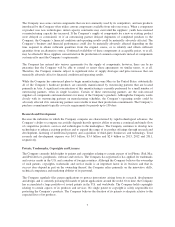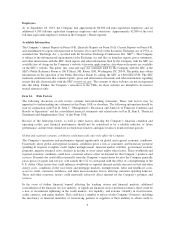Apple 2013 Annual Report Download - page 17
Download and view the complete annual report
Please find page 17 of the 2013 Apple annual report below. You can navigate through the pages in the report by either clicking on the pages listed below, or by using the keyword search tool below to find specific information within the annual report.In certain cases, the Company may consider the desirability of entering into licensing agreements, although no
assurance can be given that such licenses can be obtained on acceptable terms or that litigation will not occur.
These licenses may also significantly increase the Company’s operating expenses.
Regardless of the merit of particular claims, litigation may be expensive, time-consuming, disruptive to the
Company’s operations, and distracting to management. In recognition of these considerations, the Company may
enter into arrangements to settle litigation.
In management’s opinion, there is not at least a reasonable possibility the Company may have incurred a material
loss, or a material loss in excess of a recorded accrual, with respect to loss contingencies, including matters
related to infringement of intellectual property rights. However, the outcome of litigation is inherently uncertain.
Although management considers the likelihood of such an outcome to be remote, if one or more legal matters
were resolved against the Company in a reporting period for amounts in excess of management’s expectations,
the Company’s consolidated financial statements for that reporting period could be materially adversely affected.
Further, such an outcome could result in significant compensatory, punitive or trebled monetary damages,
disgorgement of revenue or profits, remedial corporate measures or injunctive relief against the Company that
could materially adversely affect its financial condition and operating results.
The Company is subject to laws and regulations worldwide, changes to which could increase the Company’s
costs and individually or in the aggregate adversely affect the Company’s business.
The Company is subject to laws and regulations affecting its domestic and international operations in a number
of areas. These U.S. and foreign laws and regulations affect the Company’s activities including, but not limited
to, areas of labor, advertising, digital content, consumer protection, real estate, billing, e-commerce, promotions,
quality of services, telecommunications, mobile communications and media, television, intellectual property
ownership and infringement, tax, import and export requirements, anti-corruption, foreign exchange controls and
cash repatriation restrictions, data privacy requirements, anti-competition, environmental, health, and safety.
By way of example, laws and regulations related to mobile communications and media devices in the many
jurisdictions in which the Company operates are extensive and subject to change. Such changes could include,
among others, restrictions on the production, manufacture, distribution, and use of devices, locking devices to a
carrier’s network, or mandating the use of devices on more than one carrier’s network. These devices are also
subject to certification and regulation by governmental and standardization bodies, as well as by cellular network
carriers for use on their networks. These certification processes are extensive and time consuming, and could
result in additional testing requirements, product modifications, delays in product shipment dates, or preclude the
Company from selling certain products.
Compliance with these laws, regulations and similar requirements may be onerous and expensive, and they may be
inconsistent from jurisdiction to jurisdiction, further increasing the cost of compliance and doing business. Any such
costs, which may rise in the future as a result of changes in these laws and regulations or in their interpretation could
individually or in the aggregate make the Company’s products and services less attractive to the Company’s
customers, delay the introduction of new products in one or more regions, or cause the Company to change or limit
its business practices. The Company has implemented policies and procedures designed to ensure compliance with
applicable laws and regulations, but there can be no assurance that the Company’s employees, contractors, or agents
will not violate such laws and regulations or the Company’s policies and procedures.
The Company’s business is subject to the risks of international operations.
The Company derives a significant portion of its revenue and earnings from its international operations.
Compliance with applicable U.S. and foreign laws and regulations, such as import and export requirements, anti-
corruption laws, tax laws, foreign exchange controls and cash repatriation restrictions, data privacy requirements,
15
























